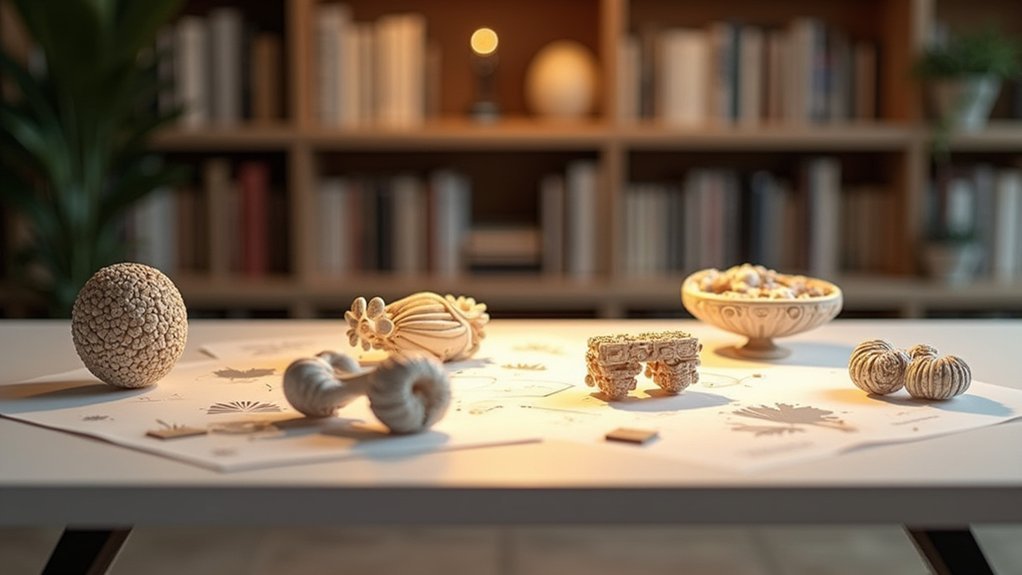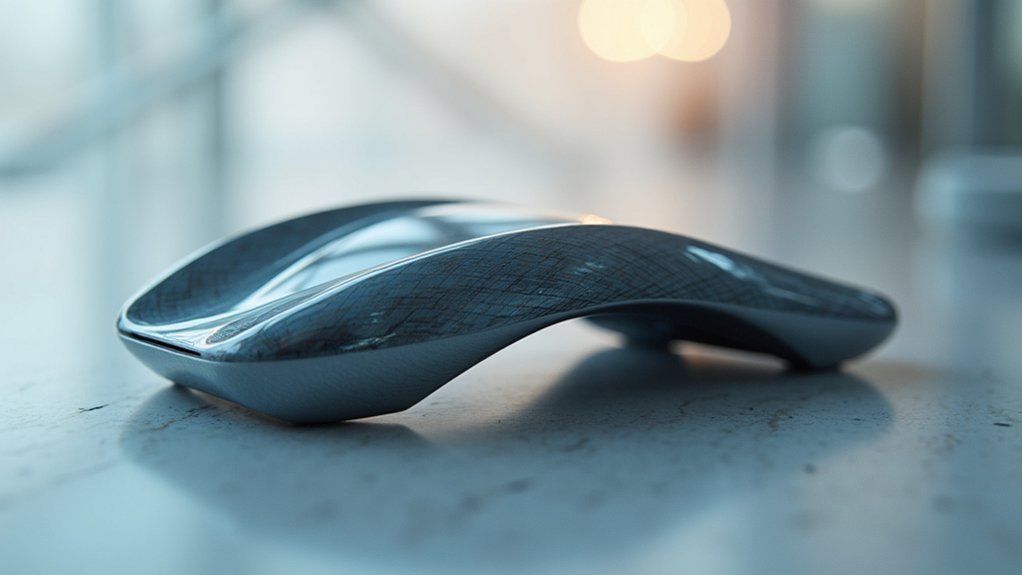You can value design IP effectively through cost-based methods that calculate development expenses, market-based comparisons using industry databases, and income projections that forecast future revenue streams. Consider relief-from-royalty strategies, patent protection assessments, copyright scope analysis, and trade secret monetization potential. Don’t overlook portfolio diversification impacts and international market opportunities that can greatly boost valuations. Each method provides unique insights into your design’s commercial worth, and combining multiple approaches will give you the most thorough understanding of your intellectual property’s true market value.
Cost-Based Valuation Method for Jewelry Design IP

Cost calculation forms the foundation of the cost-based valuation method for jewelry design IP, where you’ll determine your design’s worth by totaling every expense that went into creating it.
Cost-based valuation establishes your jewelry design’s baseline worth by calculating every expense invested in its creation.
You’ll include materials, labor, legal protections, design software, prototyping costs, and marketing expenses to establish intrinsic value. This approach works particularly well when you’re a new designer lacking market comparables or proven income streams from your designs.
While cost-based valuation provides objective assessment, it won’t capture your design’s market potential or consumer appeal.
However, you can use this method to establish baseline value for your jewelry design IP, creating a solid foundation for licensing agreements and partnership negotiations with potential collaborators or investors.
Market-Based Comparison Analysis for Design Assets
When you’re seeking to understand your design IP’s true market value, market-based comparison analysis examines recent transactions of similar design assets to establish reliable benchmarks.
You’ll need access to specialized databases like RoyaltyRange to obtain reliable data on comparable assets. This market-based analysis proves particularly effective when your design intellectual property operates within well-established markets, reflecting actual prices buyers pay.
You must make adjustments for specific transaction circumstances, such as litigation or bankruptcy sales, that might skew valuations.
Beyond determining benchmark value, this method provides valuable insights into the competitive landscape, helping you understand your design IP’s positioning relative to industry peers.
Recent transactions reveal market trends and buyer willingness to pay for similar assets.
Income-Based Revenue Projection Approach

When you’re using the income-based approach to value design IP, you’ll need to identify and project the future revenue streams your intellectual property can generate over its commercial lifecycle.
You must then calculate an appropriate discount rate that reflects the risk profile of your design asset and market conditions.
Finally, you’ll create detailed cash flow projections that account for market demand, competitive factors, and operational costs to determine the present value of your design IP.
Future Revenue Streams
Since design IP can generate substantial returns over time, the income-based revenue projection approach focuses on estimating future cash flows to determine your intellectual property’s current worth. Income-based methods rely heavily on discounted cash flow (DCF) analysis to calculate net present value (NPV) of projected earnings. Your market research must account for consumer behavior patterns and industry trends to create realistic projections.
Licensing agreements often drive ongoing revenue streams, making this approach particularly valuable for partnership negotiations. Consider these key revenue sources:
| Revenue Stream Type | Typical Duration |
|---|---|
| Direct Product Sales | 3-10 years |
| Licensing Royalties | 5-20 years |
| Partnership Agreements | 2-15 years |
| Franchise Opportunities | 10-25 years |
| International Markets | 5-30 years |
Accurate future revenue projections require thorough analysis of competitive positioning, pricing strategies, and market penetration rates.
Discount Rate Calculations
While projecting future revenue streams provides the foundation for income-based valuation, the discount rate you apply to those cash flows determines their present value and ultimately shapes your design IP’s calculated worth.
You’ll typically derive this rate from your weighted average cost of capital, which reflects the risk associated with your projected cash flows. Higher discount rates indicate greater perceived risk, greatly lowering your design IP’s present value.
Industry benchmarks range between 10% and 30%, depending on market maturity and stability. You should conduct sensitivity analysis to assess how discount rate changes impact your valuation, providing essential insights into potential risks and returns.
Accurate calculations guarantee stakeholders understand the associated risks during negotiations and investment decisions.
Cash Flow Projections
Cash flow projections form the cornerstone of income-based design IP valuation, requiring you to forecast potential earnings your intellectual property will generate over its useful life.
You’ll apply discounted cash flow (DCF) analysis to determine present value, accounting for the time value of money to capture true economic benefits.
When developing your projections, you must analyze current market conditions and industry trends that’ll impact your design IP’s performance.
Consider competitive advantages your intellectual property possesses, especially for established revenue streams like fashion designs or product packaging generating consistent royalties.
Regular updates to your cash flow projections guarantee accuracy as market dynamics shift.
This approach proves particularly valuable for licensing negotiations and investment decisions, providing reliable valuation data that reflects your design IP’s genuine earning potential in evolving marketplace conditions.
Relief From Royalty Valuation Strategy

You can implement the Relief from Royalty method by first establishing an appropriate royalty rate through market research and industry benchmarks.
Next, you’ll project the cash flows that your design IP will generate over its useful life, applying the determined royalty rate to calculate hypothetical savings.
Finally, you must incorporate risk adjustment factors to account for market uncertainties and the specific characteristics of your design IP.
Royalty Rate Determination
How do you determine the appropriate royalty rate when using the relief from royalty valuation strategy for design IP?
You’ll need to analyze historical licensing agreements and current market data to establish benchmark rates. Start by researching comparable transactions involving similar design IP assets within your industry.
Royalty rates typically range from 1% to 10% of sales, but you must consider specific factors like design uniqueness, industry norms, and competitive positioning.
Access extensive databases like RoyaltyRange to gather recent licensing data and validate your selected rates.
This valuation strategy requires careful evaluation of multiple comparable transactions to guarantee accuracy. Focus on agreements with similar IP characteristics, licensing terms, and market conditions.
The key is selecting rates that genuinely reflect current market realities rather than outdated historical data.
Cash Flow Projections
Once you’ve established your royalty rate, developing accurate cash flow projections becomes the critical next step in executing the relief from royalty strategy.
You’ll need to forecast future revenues generated by your design patents, considering factors like market penetration, pricing strategies, and competitive positioning. Base these projections on solid market data and comparable licensing agreements to guarantee reliability.
Your cash flows should reflect realistic sales volumes over the IP’s expected lifespan, accounting for market dynamics and potential obsolescence. This approach directly quantifies the economic benefit you’d receive from owning versus licensing the IP.
Remember to update your projections regularly as market conditions change, maintaining your valuation’s accuracy and defensibility for strategic decision-making.
Risk Adjustment Factors
While cash flow projections form the foundation of your relief from royalty valuation, risk adjustment factors determine whether those projections translate into reliable value estimates.
You’ll need to examine market volatility patterns that could affect your projected future cash flows over the design IP’s lifecycle. The competitive landscape plays an essential role—assess whether competitors can easily design around your IP or if substitutes threaten market position.
Your royalty rate assumptions must reflect these risks through appropriate discount rates. When analyzing comparable licensing agreements, consider whether they occurred in similar market conditions.
Industries with established licensing practices typically offer more predictable value of ownership calculations. Factor in the design IP’s maturity stage, as newer innovations face higher uncertainty than proven market performers.
Patent Protection Value Assessment for Design Elements

- Revenue generation potential through direct sales and licensing opportunities.
- Market size analysis and competitive positioning advantages.
- Brand enhancement and customer loyalty impacts.
To accurately determine worth, you’ll need income-based valuation methods that project future cash flows from your protected design.
Consider manufacturing costs, market trends, and licensing fees when calculating potential returns on your design investment.
Trademark Strength Evaluation for Jewelry Brands
Beyond patent protections, your jewelry brand’s trademark strength forms the foundation of your intellectual property portfolio’s value.
You’ll need to evaluate distinctiveness levels, from arbitrary marks offering strongest protection to generic terms providing none. Your brand equity directly impacts valuation methods, potentially contributing 30% of overall worth in competitive markets.
Market presence greatly influences trademark strength evaluation. When 65% of consumers prefer recognized jewelry brands, your trademark’s consumer perception becomes vital for capturing share in the $230 billion global market.
Legal protections through active trademark strategies can boost sales growth by 20%.
Focus on brand reputation assessment, registration enforcement, and anti-counterfeiting measures. Strong trademark portfolios create consumer loyalty while protecting market position, making trademark strength evaluation essential for accurate jewelry brand IP valuation.
Copyright Scope Analysis for Original Design Works

You’ll need to establish that your design meets copyright’s originality threshold, which requires minimal creativity beyond mere copying or mechanical reproduction.
Your analysis should identify which specific design elements qualify for protection—such as artistic expressions, visual compositions, or creative arrangements—while excluding purely functional features.
You must also understand that copyright protection typically lasts your lifetime plus 70 years, but faces limitations like fair use exceptions and the idea-expression dichotomy that prevents monopolizing basic concepts.
Originality Threshold Requirements
While copyright protection automatically attaches to original creative works, your design must clear specific originality threshold requirements to qualify for legal protection.
These standards guarantee your design works demonstrate sufficient creativity and independent creation to warrant ownership rights.
The originality assessment focuses on three key elements:
- Independent Creation – You must create the work yourself without copying from existing designs.
- Minimal Creativity – Your design needs a “modicum of creativity” that distinguishes it from purely functional elements.
- Original Expression – The aesthetic components must reflect your unique artistic choices, not standard industry practices.
Remember that copyright protection only covers artistic expression, not functional aspects.
While registration isn’t mandatory, it provides significant legal benefits including establishing public ownership records and strengthening your position in potential disputes.
Protected Design Elements
Copyright protection extends to specific visual elements within your design works, creating a protective umbrella over the creative components that make your designs unique. Protected design elements include shapes, patterns, colors, and compositional arrangements that demonstrate sufficient creativity under copyright law.
Your original design works must be fixed in tangible form and meet minimal originality thresholds to qualify for protection.
Remember that copyright safeguards expressions, not underlying concepts. Two designers can create copyrightable works inspired by identical ideas if their executions differ meaningfully. This distinction affects how you’ll value your intellectual property portfolio.
You can monetize copyright protection through strategic licensing agreements, establishing sustainable revenue streams while retaining ownership rights.
These arrangements allow controlled distribution of your protected design elements across various markets and applications.
Duration and Limitations
Understanding these protective mechanisms requires examining their temporal boundaries and inherent constraints. Copyright protection for your design IP extends through your lifetime plus 70 years, offering substantial long-term value.
However, you’ll face significant limitations that directly impact valuation and marketability.
Key constraints affecting your design IP worth include:
- Expression-only coverage – Copyright protects your specific design expression, not underlying ideas or functional elements.
- Substantial similarity threshold – Infringement claims require proving copied works are substantially similar to yours.
- Originality requirements – Your designs must be novel and original to qualify for protection.
While registration isn’t mandatory, it strengthens your position in legal disputes and provides statutory damages.
These duration benefits and scope limitations create a complex framework you’ll need to navigate when determining your design IP’s true market value.
Trade Secret Monetization Potential Review
Trade secrets represent one of the most undervalued assets in your intellectual property portfolio, yet they can deliver returns that dwarf traditional IP investments.
Unlike patents, trade secrets don’t expire, maintaining their economic benefits indefinitely through confidentiality. Your monetization strategy should start with a thorough audit identifying proprietary formulas, processes, and methodologies that provide competitive advantage.
Effective valuation methods focus on income-based approaches, quantifying cost savings and increased market share generated by your secrets.
Market analysis reveals licensing opportunities where you can generate revenue without public disclosure requirements. Strategic partnerships can reveal additional value streams while preserving confidentiality.
Portfolio Diversification Impact on Design Value
While single-focus design portfolios may seem strategically sound, diversification across multiple design categories and markets creates exponential value that transforms your IP from liability into competitive weapon.
Portfolio diversification delivers tangible benefits that directly impact your bottom line:
- Enhanced Value Stability – Spreading exposure across different markets reduces risk and creates consistent revenue streams, with diversified firms reporting 30% higher valuations than single-focus competitors.
- Strengthened Market Appeal – Multiple design areas showcase innovation breadth, attracting broader customer bases and increasing licensing agreements opportunities.
- Reinforced Brand Identity – Diverse design IP demonstrates extensive creative capabilities, positioning you advantageously for partnerships while ensuring long-term profitability through adaptability to shifting consumer preferences and volatile market conditions.
International Market Consideration for Global Design Rights
Although design portfolios can achieve strong domestic valuations, you’ll unfasten exponential value when you strategically navigate international markets where legal frameworks, cultural preferences, and economic conditions create dramatically different IP landscapes.
Understanding regional variations in design IP valuation becomes essential for maximizing perceived value. The Asia Pacific region presents extraordinary growth opportunities as expanding economies drive increased market acceptance for innovative designs. Meanwhile, harmonization of design rights through international treaties like the Hague Agreement streamlines protection across multiple jurisdictions.
| Region | Legal Framework Strength | Market Growth Potential |
|---|---|---|
| European Union | Robust community designs | Moderate expansion |
| Asia Pacific | Variable protections | High growth trajectory |
| North America | Established systems | Steady development |
Cultural preferences greatly impact your design’s economic potential across different markets.
Frequently Asked Questions
What Are the Methods of IP Valuation?
You’ll find three primary IP valuation methods: market-based, which analyzes comparable transactions; cost-based, which calculates development expenses; and income-based, which projects future economic benefits using discounted cash flow analysis.
How Do You Value Your IP?
You’ll start by identifying your IP type, then apply income-based methods calculating future cash flows, market-based comparisons using transaction databases, or cost-based assessments totaling development expenses for accurate valuation.
What Is the Rule of Thumb for IP Valuation?
You’ll typically multiply your IP’s annual revenue by 2-5 times, depending on industry standards. Alternatively, you can base valuations on development costs or use relief-from-royalty methods for quick estimates.
How to Value IP Income Method?
You’ll estimate future revenue streams from your IP, then discount them to present value using appropriate risk-adjusted rates. Consider the relief from royalty approach if you’d otherwise license similar assets externally.
In Summary
You’ve got multiple pathways to value your design IP effectively. Whether you’re calculating replacement costs, analyzing comparable market transactions, or projecting future revenues, each method offers unique insights. Don’t rely on just one approach—combine cost, market, and income analyses for thorough valuations. Remember that your IP’s worth extends beyond immediate returns. Consider international markets, portfolio synergies, and long-term protection strategies. Your design assets can become significant revenue drivers when properly valued and strategically leveraged.





Leave a Reply